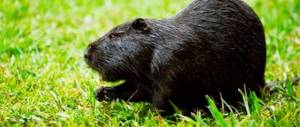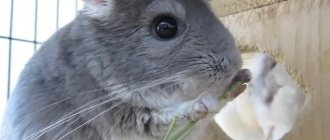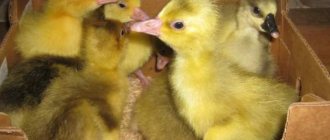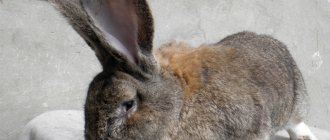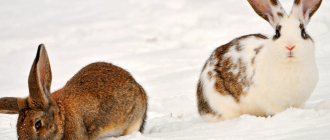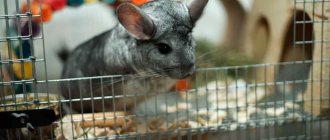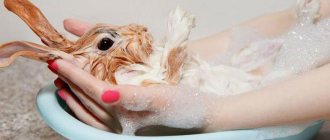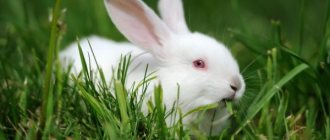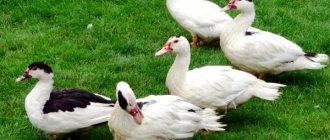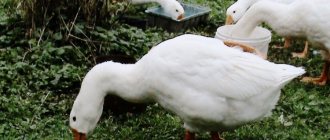Choosing a breed for breeding
Meat rabbit farming predominates; breeding rabbits for fur is not common. Rabbit meat is tasty, nutritious, easily digestible, and suitable for dietary nutrition. Fur clothes and hats are sewn from the skins, and hoods and shoes are trimmed.
For meat
The most popular breeds for breeding for meat are:
- California rabbit;
- New Zealand (red and white);
- French ram;
- Flanders
These types of rabbits are characterized by rapid weight gain; breeding does not require large amounts of feed. By 4-6 months, the young individual weighs about 5 kg.
For skins
The following breeds are selected for breeding for skins:
- silver rabbit;
- Viennese blue;
- black-brown;
- Soviet chinchilla;
- Russian ermine.
For meat and fur
Breeds of rabbits popular for breeding for both fur and meat:
- butterfly;
- giant (white and gray);
- chinchilla.
What to consider when purchasing
To successfully start a business from scratch, you should know what criteria to use to choose rabbits for breeding:
- the coat is smooth, shiny, without tangles or bald patches;
- the body is flexible, the muscles are developed;
- the back is elongated, without sagging;
- the ears are covered with short fur on the outside and light pink on the inside;
- ear cartilages unbroken;
- the bite is correct, the upper jaw protrudes above the lower jaw;
- eyes are clean, no redness or discharge;
- the nose is clean, cool and moist to the touch;
- the rabbit does not panic when a person approaches and behaves adequately;
- the area around the anus is clean, the fur is not stained with dried feces;
- the belly is soft, no lumps can be felt;
- the genitals are clean, without discharge, the skin is pink.
To have healthy and purebred rabbits, you should purchase from an experienced farmer who cares about his reputation.
Methods of content
Industrial breeding of rabbits requires not only a lot of money and labor, but also a large space: a farm, a summer cottage. Pets are kept in closed rabbitries or in open cages, pits, and enclosures.
Expert opinion
Zarechny Maxim Valerievich
Agronomist with 12 years of experience. Our best country expert.
Ask a Question
Rabbits are kept indoors during the cold season, but in the warmer months it is better to provide them with an outdoor area.
Cells
Cage equipment is the most convenient and common option of all possible methods of keeping rabbits. Its advantages:
- the ability to accurately dose feed;
- ease of monitoring the condition of individuals;
- exclusion of uncontrolled reproduction;
- ease of breeding, care, disinfection, vaccination.
It is convenient to keep cages in a barn, a specially built rabbitry, and even in a private house if there are few rabbits. The structures can be made portable to allow animals to be taken outside into the yard during the warmer months.
Rules for making cages at home for beginning farmers:
- The optimal cage size per individual is 1 m2.
- The cage should be divided into two sections: open and house.
- A queen cell is placed in the cage of a pregnant rabbit - a box for baby rabbits measuring 50x30x25 cm, the diameter of the hole should be 18-20 cm.
- Partitions and doors make it convenient to clean and disinfect cells.
- The back and side walls of the cage are wooden, the front is mesh.
- The bottom is wooden or plastic, but not made of metal mesh, otherwise the rabbits will cut their paw pads.
- A removable tray for urine and feces is installed under the floor of the cage.
See also
Instructions for use of the VGBV vaccine for rabbits, types of vaccinations and dosesRead
Aviaries
To keep rabbits in conditions close to natural, enclosures are built.
Advantages of breeding in such conditions:
- rabbit activity;
- ensuring strong immunity;
- low maintenance costs.
The enclosure fence is buried 60 cm into the ground, its height above ground level should be 1.5 m. A space of at least 1 m2 is required for one individual. The fence is made of mesh, boards, slate plates. A canopy is installed over the enclosure to protect from precipitation and sun.
Pits
The pit breeding option is chosen by farmers who breed rabbits for meat. Raising rabbits for their fur in this manner is unacceptable. Pits are made both in the country and in urban areas. The main thing is a low groundwater level and soil without stones.
To breed 20 rabbits, dig a hole 2x2x1 m. The floor can be left empty, or it can be covered with a net or boards, under which you can make a slope for waste (or place a pallet). If the floor is left empty, it is lined with straw, which must be replaced regularly.
This method of breeding rabbits is convenient, but there are several significant disadvantages:
- inability to control reproduction;
- the appearance of offspring with anomalies due to inbreeding;
- gradual feralization of rabbits;
- frequent fights between males.
Sheds
It is convenient to raise rabbits in sheds - long sheds in which non-portable cages are placed in rows in several tiers. This method of breeding significantly saves space, making it possible to raise a large number of individuals at the same time. In warm months, the shads are not heated; in winter, the heating system must be turned on.
Mini farms
Academician Igor Nikolaevich Mikhailov developed designs that are convenient on farms where large livestock are planned to be raised. Spacious cages are installed in 2-3 tiers, accommodating 20-25 individuals. Cell design:
- pitched roof;
- mesh floor for exit of feces and urine;
- outer pipe for gas exchange;
- insulated northern wall;
- south wall opening for ventilation.
To simplify the care of rabbits in cages, automatic feed and water supply and waste removal systems are installed.
DIY rabbit cages
When constructing cages, attention must be paid to ease of maintenance, hygiene, as well as simplicity of design and low cost of building materials. The greatest attention should be paid to gender:
- In warm and temperate climates, the floors of the aft compartment are made of wooden slats (oak, maple). You can also use plastics, stamped metal and metal mesh.
- The nest compartment or nest should have solid wood floors.
- In cooler climates, floors are made of planks or double-height.
These rules also apply to the arrangement of floors in portable cages. If the farm prefers to keep livestock on solid plank floors, you need to make a slope of 5 centimeters towards the rear. To install a double floor, you can use a mesh, on top of which a removable plank floor is laid. This design is considered the most hygienic, since the removable floor can be easily cleaned of dirt and droppings.
Note: Animals should not be allowed to be kept on mesh floors for a long time, as in this case they will develop pododermatitis.
In homestead farms, two-section cages are considered the most popular, but for a large number of livestock the shad housing system is more suitable. Sheds can be of any length, depending on the number of individuals. In addition, sheds can be single- or double-tiered. If the cages in the shad are placed in two tiers, a simple mechanism (suspended road) is installed between them, with the help of which one person can serve a large number of adults and young animals at once.
Figure 5. Shadow content
In addition, a metal frame and mesh are used for construction. In most cases, such cages are intended for keeping livestock indoors, but in the summer they can be taken out into the fresh air. Also, the farm should be equipped with separate uterine or portable cages, which are made of plywood or wood. If you install a heater in them, chicks can be obtained not only in spring or summer, but also in winter. Recommendations for building cages for rabbits with your own hands are given in the video.
Large cages with partitions are considered an excellent option for keeping young animals on the skin. First, they are divided in half by partitions, and in each compartment there are six individuals of the same age, weight and development. As it grows, the cage is divided into 12 parts by ten partitions, so that each rabbit is kept separately until slaughter (Figure 5).
Note: Housing in such cages has a number of advantages. Firstly, the skins are not damaged, their quality improves overall. Secondly, it becomes possible to send individual individuals for slaughter after molting is complete.
You can make cells yourself using the drawings shown in Figure 6.
Nuances of care
Rabbits are sensitive to environmental conditions, get sick if the farmer does not want to care for them properly, or ignores hygiene rules. It is necessary to clean the rabbitry 2 times a week, change the bedding in the cage, disinfect equipment, wash drinkers and feeders daily, change water, remove rotten food and feces. It is better to use straw or sawdust as bedding.
Rabbits should be kept in a room where the temperature is from +18 to +20 °C, air humidity is about 50%, there is good ventilation, but there are no drafts.
In the summer months, sunlight is sufficient, and if the weather is clear, a shading canopy is used. In winter, the installation of additional lighting sources is required.
Aviary breeding of rabbits
Keeping rabbits in an open-air enclosure brings them closer to life in natural conditions, which promotes rapid growth and reproduction of animals. This method is convenient for short-term (seasonal) cultivation. One family requires an area of 75 square meters. m. (1 sq.m. per 1 rabbit).
When animals are allowed to walk around the clock, the walls are attached to the barn, which will serve as shelter from rain and wind. Sheds and cages are also used for these purposes.
The walls of the enclosure should provide rabbits with isolation from outside animals, which will protect them from enemies. The material for constructing the fence is metal mesh (rabbits are protected from enemies while within the farmer’s visibility). The height of the fence is 0.8 m, the depth is 0.5 (rabbits dig the ground, the fence is necessary not only from the outside).
Feeders and drinkers are located along the wall (under a canopy).
Important! Feeding containers should always be clean and food fresh.
Cleaning is done once every 2 weeks.
Animals are allowed into the enclosure once (their ages must be the same), sharing is unacceptable (to avoid fights). If necessary, the fence is completed, dividing the territory into sectors.
Features of the diet for feeding
To raise healthy rabbits, you need to properly prepare a diet for them. It should be balanced and varied, including:
- hay;
- grass;
- vegetables, roots, twigs;
- compound feed;
- grain food.
Overfeeding rabbits is unacceptable. It leads to obesity, due to which animals become less active and produce few offspring. During the cold period, rabbits are given more root vegetables and vegetables (zucchini, carrots, pumpkin, fodder beets, boiled potatoes) and silage. Hay and succulent plant foods should make up 30% of the diet, and mixed feed and grain feed – 70%.
You should not feed rabbits:
- legumes;
- nuts;
- raw potatoes and food beets;
- cabbage;
- pasta and bakery products;
- sweets;
- meat and sausages;
- waste from the master's table.
Feeding the animals
In order for rabbits to actively grow and not get sick, they must eat a certain portion of food daily. Their diet must include both concentrates and succulent and roughage feed. For example, dried grass should be in their cage at all times.
You can read about how to make food for rabbits with your own hands in our special article.
The diet of rodents should be varied
These rodents are often given branch food - these can be branches of various trees, including currants, apple trees, oaks, and maples. Juicy foods include potatoes, carrots, beets - all this can be given to pets without heat treatment.
Important point! Some farmers strongly discourage feeding cabbage to their pets, because it causes gas formation in the intestines.
Vitamins and minerals
Animals urgently need various supplements based on vitamins and minerals, which is why it is recommended to include the following components in the diet of rabbits:
- fish oil (source of vitamins A and D);
- feed yeast (source of vitamin B12 and protein).
It is recommended to add chalk, bone meal and salt to food as a source of mineral components.
Grated chalk is added to pets' diets
Feed chalk prices
Chalk stern
Features of feeding in winter and summer
In the warm season, the basis of the rodents' diet is greens. However, you should not give them too much grass, otherwise it will lead to digestive problems. In addition, it is recommended to dry it for 2 days.
List of herbs allowed for rabbits:
- clover;
- mouse peas;
- nettle;
- sow thistle;
- tansy;
- burdock;
- sorrel;
- white sweet clover.
Herbs useful for rabbits
In the cold season, pets are switched to concentrates and root vegetables. Many farmers prefer to feed their livestock wet mash.
Wet mash recipe for rodents: step-by-step instructions
Step 1. First you need to prepare all the components of the mash. This will include potatoes, crushed nettle leaves, dried dill, salt, crushed feed mixture.
Preparing the ingredients for the wet mash
Step 2. The potatoes should be thoroughly washed, then cut into pieces, put in a saucepan and covered with water. Now you need to salt the potatoes, close the lid and put on the stove.
When the potatoes become soft, add dried dill to the container and cover with a lid.
Step 3. After a few minutes, you need to remove the container from the stove, drain the excess liquid and remove the dill.
Now you can add the remaining components to the container and crush them
Finally, you can add some corn kernels. The result is a nutrient mixture for feeding rabbits.
Prices for feed for rabbits
Compound feed for rabbits
What is prohibited from feeding rodents?
There are some foods that cause problems with the digestive system in animals. It is recommended that you familiarize yourself with this list:
- legumes (they can be given only in minimal quantities);
- bakery products;
- nuts;
- sausages;
- sweets.
There are also some herbs that cause poisoning in rodents. These include dope, spurge, and wild garlic.
Ramson (flask) is prohibited for feeding rabbits
Recommendations from rabbit breeders
Some novice farmers often forget to water their rabbits according to the rules. This, in turn, provokes digestive disorders in animals.
For example, in the winter season, pets should be given warm water at every feeding, because then it will freeze. If this is not possible, then it is better to install drinkers with an automatic heating system. In summer, drinking bowls should always be filled with cool water.
Like any animal, rabbits should not suffer from thirst.
Animals are not given straw as food, which is also a common mistake for beginners. It should only be used as floor insulation and should not be expected to be eaten by rabbits.
Mating, pregnancy and childbirth
In rabbits, reproduction occurs outside of the seasons. Thanks to their high fertility, it is possible to breed a large population in a short time. In summer, a female rabbit's estrus lasts 8-9 days, in winter – 5-6. Individuals are distributed so that a male covers 8 females.
See also
Is it possible to keep rabbits and chickens in the same room, pros and consRead
A female rabbit can mate 5 times during the year and produce up to 40 cubs. There are 6-12 rabbits in a litter. A couple of days after giving birth, the female is ready for new breeding. Females that have reached 5 months of age and 7-month-old males should be bred. The female is placed in a cage with the male for 10-15 minutes.
Pregnancy lasts 28-30 days. A pregnant individual becomes aggressive and does not allow herself to be touched. The rabbit is carefully looked after, protected from stress, and the daily portion of food is increased. Before giving birth, the female rabbit builds a nest from straw and fluff torn from her breast. There is no need to help the female during childbirth.
Features of keeping rabbits in unusual conditions
In order to save space for a separate enclosure, for the purpose of combined feeding and cleaning of animals, farmers sometimes try to unite them and house them together.
Keeping rabbits with other animals
You can keep rabbits and other pets together, for example, rabbits and chickens are housed in the same enclosure. Only the owner of the rabbit-chicken coop can evaluate how advisable it is to keep them together.
Living in an undivided enclosure, even with full compliance with all veterinary sanitation measures, is not recommended. It must be taken into account that rabbits are by nature calm animals that need silence, which their close proximity to chickens cannot guarantee.
Noisy and loud, chickens bother neighbors with their sociability. The nutrition of chickens and rabbits is in many ways similar, but with regular replacement, rabbits may develop digestive disorders.
Keeping chickens with rabbits
Both also have common diseases, for example, coccidiosis. If diseases occur, it is necessary to immediately provide veterinary care to animals, removing sick ones, otherwise you can lose the entire livestock in a matter of hours.
Features of keeping rabbits together
Creating strong and healthy offspring is the main goal of rabbit breeding. Some of the important periods in the life of animals are: the time of preparation for birth, birth, female pregnancy, reproduction, raising young animals. It is recommended to make the cages in two sections, dividing them into zones for feeding and so that the female can create a nest for herself. In winter, the cages are covered with plywood panels, which are removed in the summer. After weaning from breastfeeding, the young animals are kept in groups; after three months of age, groups are formed by selecting babies similar in temperament. Pugnacious individuals have to be kept in separate cages. Males, unlike females, have to be kept alone.
Cage for a four-legged giant
On farms, group cages are built, designed to contain groups of young animals of different ages; the cage sizes allow 8–10 rabbits to be placed in each cage. The seating scheme of individuals also depends on the time of year - in the summer, farmers place the young animals in individual cages, in the winter they plant them in groups. The formation of groups includes the selection of same-sex rabbits that are similar in weight.
Queen cell for a female with rabbits
When building cages, special attention is paid to the floors, when arranging them they tilt towards the rear wall. They must be removable, this is required for cleaning; keeping animals on a mesh floor is not recommended, in this case the rabbits get sick; flooring is necessary.
Portable cage option
Rabbits must be kept clean, and selective breeding work must be carried out with them. The quality of the hair improves when rabbits are kept outdoors or have the opportunity to walk.
Raising young animals
Rabbits are born blind and naked, begin to see after 10 days, and are covered with fur after a month. From the 3rd week of life, baby teeth begin to change to permanent ones.
A young individual weighs:
- 50-60 g immediately after birth;
- 80-120 g after 2 days;
- 2-3 kg after 3-4 months.
The rabbits should not be touched until they are covered with fur, otherwise a nervous rabbit may destroy them. After 50-60 days from birth, the offspring are separated from the mother. Young rabbits should be raised in the same conditions as mature rabbits. The cage should have plenty of space to keep your pet active.
Pros and cons of cellular housing
Most rabbit breeders believe that with proper care, the animal grows in a cage to be more resistant to infectious diseases. But there are both pros and cons to this method.
Find out how to build and furnish a rabbit house with your own hands at home.
Advantage of cellular content:
- you can monitor the health of the animal and prevent diseases;
- the ability to control reproduction;
- control of animal feeding;
- This is an economical option, since you can make the cage yourself.
Disadvantages of keeping a rabbit in a cage:
- cleaning takes a long time;
- The immunity of animals decreases.
Methods for slaughtering rabbits
When bred for meat, rabbits are slaughtered at 4 months of age. To obtain fur, the slaughter period is delayed to 6-7 months. There are several methods of slaughter:
- mechanical (the most common);
- electrical discharge;
- French (vascular rupture);
- using an automatic pin;
- embolism (introduction of air bubbles into a blood vessel);
- neck twisting.
In the mechanical method of slaughtering meat or fur, a heavy object is struck forcefully on the forehead, back of the head, or nose of the animal, which is suspended upside down. The carcass is hooked onto a spreader, the skin is torn off, gutted, and the blood is bled out.
Rabbit diseases: symptoms and their treatment
Rabbits are susceptible to many infectious and non-infectious diseases, of which the most common are:
- Pneumomycosis is a fungal pulmonary disease accompanied by sneezing, difficulty breathing, and yellowing of the mucous membranes. Associated with poor hygiene. There is no treatment, sick individuals are killed, the cells are treated with formaldehyde.
- Myxomatosis is a fatal viral disease manifested by nodular formations on the head and in the genital-anal area. For prevention, animals are vaccinated.
- Hemorrhagic viral disease is another incurable disease. Therefore, we must not forget about timely vaccination.
- Scabies, manifested by peeling skin. The affected body is lubricated with turpentine. The cage is disinfected.
- Bronchitis appears from temperature fluctuations and drafts. Suitable medications are Brovaseptol, Tromexin, Brovafom.
- Helminthiasis occurs due to poor hygiene. The drug “Naftamon” is used for treatment.
- Conjunctivitis occurs due to eye injuries or retinol deficiency in the rabbit's body.
- Mastitis in a nursing rabbit is manifested by hardening and redness of the nipples, and the appearance of ulcers. The disease is serious and should be dealt with by a veterinarian.
To prevent a possible epidemic, the purchased rabbit is kept in quarantine for 3 weeks.
Mistakes of inexperienced farmers
Beginning farmers make primitive mistakes in breeding rabbits, which is why their business collapses. You cannot do the following:
- forget about maintaining hygiene in the rabbitry;
- place cages in heat and draft;
- ignore vaccinations and preventive visits to the veterinarian;
- give rabbits food without checking for the presence of poisonous herbs (milkweed, bindweed, tansy, larkspur, hemlock, wild garlic, datura);
- ignore the underdevelopment of the maternal instinct in the female rabbit (females who refuse their offspring and devour them are not allowed to breed).
Also, a novice farmer must take into account the moral side of raising rabbits. Not everyone can kill animals and gut them. You can entrust this matter to another farmer, but then the cost of production will increase, which will negatively affect the profitability of the business.
Keeping rabbits in the wild
New breeds that were obtained relatively recently, in addition to improved characteristics, have become extremely sensitive to external factors of the surrounding world. Some rabbit breeders believe that freedom and free time can restore the animals' former stamina.
It has been noticed that once in a familiar natural environment, rabbits grow better, mate more often, and strengthen their weakened immunity. In addition, it is more economically profitable and more interesting for breeders to breed “free” animals.
Video Three ways to keep rabbits. Cages, Rabbit Pit and Enclosure - Pros and Cons.
Contents in the pit
A pit is one of the options for “free” housing for eared pets. Some gourmets note that rabbit meat from pit animals is very tender and has a unique taste.
Rabbits of the Californian, Burgundy, and New Zealand breeds are suitable for this type of living, as well as Rex, Gray Giant, Soviet Chinchilla, and of course hardy domestic mongrel rabbits.
Each owner digs a hole at his own discretion, because there are no clear recommendations and drawings. The top is covered with a roof or a superstructure (shed) is made. Be sure to take care of maintaining the temperature and adjusting air ventilation. To prevent digging of holes, the walls of the holes are covered with slate or cemented.
The floor can be left in the ground, but it is more practical to cover part of the bottom with slats, mesh or plywood. It is advisable to leave space for further excavation in order to expand the space. It will be more convenient for female rabbits to equip nests in the ground.
Keeping rabbits in a pit
When the hole is ready, a male and several female rabbits are launched into it. Then all that remains is to periodically clean and feed the animals. One pit structure can accommodate up to 200 long-eared animals. Unclaimed basements or cellars are also used for this type of residence.
It happens that the chosen location for the holes is not suitable for digging. It becomes unusable if:
- in this area there is an increased level of groundwater;
- The climate of the region is very harsh, and in winter the soil freezes deeply.
| Positive aspects of the pit method of keeping | Disadvantages of pit housing |
| • Minimum set of necessary building materials and equipment. • Quickly built. • There are no drafts. • Durability of the structure. • Saving territory. • Easy to care for, not as often as in cages. • Rapid reproduction. • The immunity of rabbits is increased. • Eared animals become more independent, they exhibit defensive reactions towards other animals. • Maternal instincts in females increase. | • There is no way to control the process of mating and the birth of offspring. • Cannot be disinfected. • Total mortality of livestock when a pathogen of a dangerous disease enters. • Difficulty removing litter. • Many males are injured due to constant fighting. |
In pits, rabbits become wild, aggressive, and are often very difficult to catch. To teach animals to gather and not hide in holes, you can, for example, conduct feeding while listening to the sound of a whistle or flashing flashlight. And when the eared ones gather, it will be possible to catch the desired animal with an ordinary net.
Video Pit rabbit breeding. Full overview, feeders, trap, drinking bowl.
Keeping on pasture
Caring for rabbits that freely graze on the site is kept to a minimum. Typically, the grazing territory is divided into three parts: grazing is carried out on one, the sown grass grows on the other, and the third is just being sown at this time. Thus, uninterrupted power supply is easily ensured.
If a meadow adjoins the site, then it can also be used by periodically applying fertilizer and sowing the necessary plants there. For sowing, oats, bentgrass, timothy, and legumes (clover, vetch, alfalfa) are used. It doesn’t hurt to mix in the seeds of wormwood, dandelion, tansy, plantain, mantle, and fireweed when sowing.
The pasture area is lined with shrubs (for example, willow), which will act as a fence, while at the same time the rabbits will sharpen their teeth on their branches. You can even organize a pasture in the garden, but in this case you should protect the crown of the fruit trees so that the eared animals do not damage them. So that the little ears do not suffer from bloating, and the grass is well absorbed, hay is periodically scattered over the feeders.
Video Keeping rabbits free in the yard - rabbit pen
Senniks, feeders, and drinking bowls should be placed under a well-equipped canopy, which will protect the animals from rain and strong winds. Under shelter, animals will be able not only to rest and hide from bad weather, but also to reproduce. You can dig holes or install artificial boxes buried in the ground in the pasture. Rabbits will definitely like this kind of entertainment, they will happily relax there.
It is interesting that it is in such burrows that females willingly nest and give birth, and then safely leave their newborns, going to the pasture to profit. Minks can be made of stone, boards, or brushwood. The bad news is that rabbits cannot graze freely all year round, and they still have to be taken off the street for the winter.
The number of holes in the pasture should exceed the number of livestock. Every rabbit has the right to its own nook!
